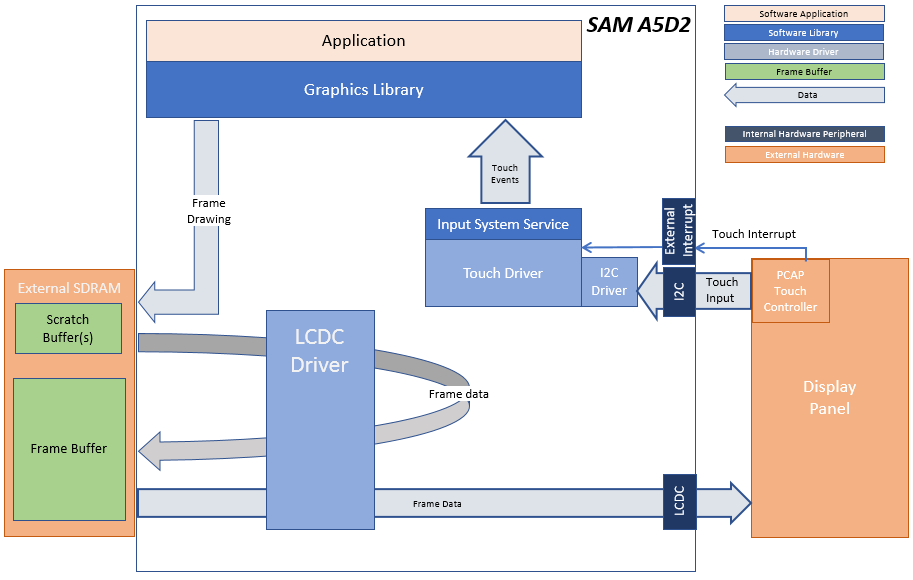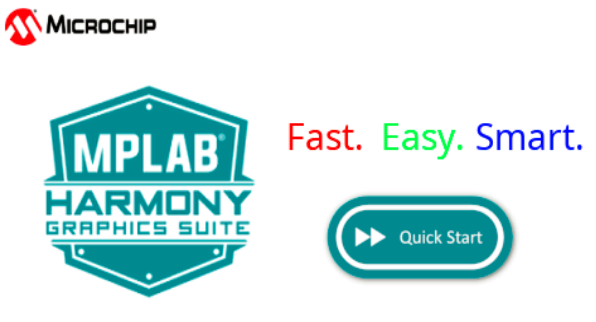 legato_qs_a5d27_som1_ek1_tm5000.X
legato_qs_a5d27_som1_ek1_tm5000.X
Defining the Architecture

This application demonstrates multi-layer WVGA graphics using SDRAM memory.
User touch input on the display panel is received thru the PCAP capacitive touch controller, which sends a notification to the Touch Input Driver. The Touch Input Driver reads the touch information over I2C and sends the touch event to the Graphics Library thru the Input System Service.
Demonstration Features
- Legato Graphics Library
- Reference application for the SAM A5D27 SOM1 EK1
- 24-bit color, multi-layer, WVGA (800x480) screen design
- Time system service, timer-counter peripheral library and driver
- Graphics Acceleration using integrated display controller (LCDC)
- I2C and touch controller driver
Creating the Project Graph

The Project Graph diagram shows the Harmony components that are included in this application. Lines between components are drawn to satisfy components that depend on a capability that another component provides.
Adding the SAM A5D27 SOM1 Kit1 BSP and Legato Graphics w/ PDA TM5000 Display Graphics Template component into the project graph will automatically add the components needed for a graphics project and resolve their dependencies. It will also configure the pins needed to drive the external peripherals like the display and the touch controller.
Building the Application
The parent directory for this application is gfx/apps/legato_quickstart. To build this application, use MPLAB X IDE to open the gfx/apps/legato_quickstart/firmware/legato_qs_a5d27_som1_ek1_tm5000.X project folder and press F11.
A successful build will generate a harmony.bin file in dist/lcdc_rgba8888_mxt_a5d27_som1_ek1_wvga/production inside the project folder.
The following table lists configuration properties:
| Project Name | BSP Used | Graphics Template Used | Description |
|---|---|---|---|
| legato_qs_a5d27_som1_ek1_tm5000.X | SAM A5D27 SOM1 Kit1 | Legato Graphics w/ PDA TM5000 Display | ATSAMA5D27-SOM1-EK1 with RGBA8888 GFX and 5” WVGA PCAP Touch display |
**_NOTE:_** This application may contain custom code that is marked by the comments // START OF CUSTOM CODE … and // END OF CUSTOM CODE. When using the MPLAB Harmony Configurator to regenerate the application code, use the “ALL” merging strategy and do not remove or replace the custom code.
Configuring the Hardware
Configure the hardware as follows:
-
Connect the ribbon cable from the display to the LCD connector J26 on the ATSAMA5D27-SOM1-EK1.
-
Take an SD Card formatted with FAT32 file system, and copy the boot.bin binary file from this location. Also copy the harmony.bin file you generated from the “Building the Application” section.
-
Insert the SD card into J12 on the ATSAMA5D27-SOM1-EK1 and power up the board by connecting a powered USB cable to the USB port J10 on the board.
Running the Demonstration
When power-on is successful, the demonstration will display a menu similar to the one shown in the following figure (different configurations may have slight variation in the screen aspect ratio):
